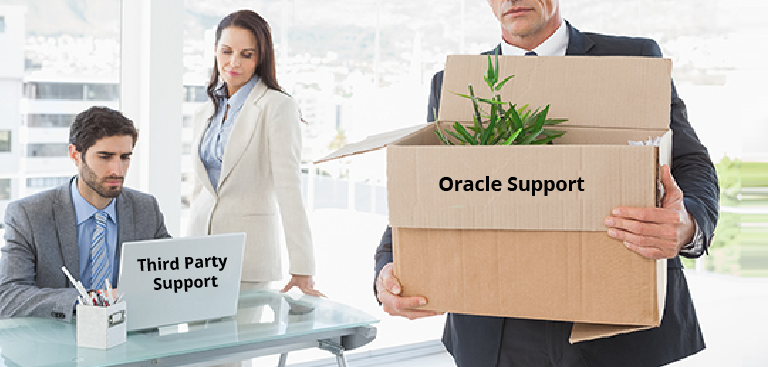Draining the FUD Swamp to Escape Oracle Support

Making a move to a third-party support vendor has considerable advantages. But to reap the benefits, organizations need to break the chains that bind them to Oracle support and maintenance contracts.
In the Escape Story series of the Escape Hatch from Oracle Research Mission of EarlyAdopter.com, you will learn how four executives regained control of their IT infrastructure. Find out how these trailblazers successfully steered their organization’s ERP system away from Oracle support to third-party support, saving millions of dollars and substantially improving the quality of service.
Siphon off the FUD
Migrating away from Oracle maintenance and support requires a strong plan The fine print around contracts, licensing agreements, updates, audits, security, and data privacy needs to be carefully reviewed to understand the long-tail costs.
Before taking that path, organizations need to assess their IT roadmap while working their way through the fear of what’s holding them back. In the course of our research, these common fears emerged:
- Fear of Catastrophic Outage After Ending Support
- Fear of Cybersecurity Breaches
- Fear of Leaving the Oracle System
- Fear of Leaving Oracle Forever
- Fear of the Third Party Support Model
Shedding the fear is a top-down process that starts with senior IT executives digging in and identifying what the facts are and what’s fiction. A good place to start the journey is to conduct a thorough risk assessment to determine if these fears still have merit in the current operating environment.
Understand what’s at risk
- Timing is a considerable factor. Planning ahead of Maintenance End Dates and contracts is key. Once the planning is done, the switchover can happen in three or four weeks.
- Availability of core systems that are fundamental to the business needs to be preserved. Avoiding outages or downtime is critical.
- Security is another area of concern that needs to be assessed. Are files and data vulnerable if patches and updates are not automatically installed? What other security approaches are available?
Knowing the answers to key questions and sifting the facts from the fiction is vital. Once the IT leadership team siphons off the fear, uncertainty, and doubt (FUD), the journey forward will be more straightforward.
Our Trailblazer: Meet Jeremy Smith
Jeremy Smith (a pseudonym) is a Senior Support Executive from a large US-based Food and Beverage company.
After 13 years, a large US-based Food and Beverage company decided to call time on Oracle’s support and move to third party support provided by Rimini Street. Although their ERP system had been running on the same release version for many years now, they had gone the distance, spending millions of dollars paying for maintenance contracts that no longer met their needs and even paying for Oracle support on licenses they weren’t using.
Like many other organizations, Jeremy’s company needed to cut costs. The support and maintenance of the decade-old ERP system had long been tied to Oracle. The time had come to explore whether third-party support vendors could step in and provide the necessary support at a lower price tag.
A decade too long
Keeping the system running for over a decade wasn’t cheap. The long-tail investment of choosing Oracle as the single ERP solution was huge. By sticking with one vendor, the organization dodged the process of replacing a core system. But, that privilege came at a high price.
For starters, the system had cost three-times the estimated amount to implement. Then, a decade of support contracts and licensing costs had racked up millions in fees. At the same time, the company experienced a steady dip in revenue and growth.
As the software aged, the internal Oracle expertise had left while other support jobs were outsourced. The company now employed a managed support team co-located on- and offshore. The team’s responsibilities included managing support incidents, working the tickets, and liaising with Oracle.
The software’s currency was nearing the end of its support cycle. It was about to roll over to sustaining support, meaning it was no longer fully supported by Oracle, exposing the business to risk.
Diminishing return on investment
When the Oracle ERP system was first purchased, the total cost of ownership (TCO) was a considerable factor in its favor. “The board and leadership team were sold on the overall TCO proposition, including the initial investment in the software and licensing, the cycle and expense of continuously upgrading to a new version every few years, and the cost of supporting and maintaining the systems using Oracle support,” explains Jeremy Smith, a Senior Support Executive from a large US company.
The ERP system purchased included different modules and licenses. The bigger the bundle, the better the price. It’s a bit like the three-for-one deal you see at the grocery store. The organization ended up with more in the cart than what they really needed.
“It wasn’t until the implementation stage that we realized we had a lot more than we needed. Certain modules didn’t work well with other solutions we already used; some of the modules were redundant as other solutions were in place; and, we ended up with about a quarter more licenses than what was required,” says Jeremy.
By the time the implementation was over, and the new ERP system was finally operational, the company just wanted to get back to running the business.
Fast-forward to 2012
In the next several years, as the company’s revenue and operating model slowed down, they cut staff to reduce costs.
Seven years later, the company is operating with fewer IT staff. The ERP system that’s been in place for ten years is now several generations removed from the latest releases available. Oracle is no longer fully supporting the installed version of Oracle ERP (version 11.5.10). Sustaining support is needed
When Oracle stops fully supporting a back-level version of its software, customers are given the option to pay for sustaining support or upgrade the software. Both paths are expensive.
“Upgrading to version 12.2 just wasn’t feasible. We couldn’t upgrade, we didn’t have the people anymore, and we couldn’t afford it. That’s when we realized we were stuck and needed to find another solution,” explains Jeremy.
The budget quandary
The IT department would need to spend $4 to $5 million to upgrade and continue receiving full support. External consultants would need to be hired to manage the process which added to the expense. Under pressure to cut costs, the CIO took a hard look at the biggest line item in the budget; Oracle support. “We were paying $1.3 million for Oracle break-fix support and faced a 10% uplift when we moved to sustaining support,” adds Jeremy.
Budget and resources were not the only hurdles this organization encountered.
Regulatory updates and payroll
The organization was also running Oracle payroll. Moving to sustaining support meant that Oracle would stop supplying regulatory upgrades to payroll.
To get through the year, the company would need to pay an extra $50,000 to continue receiving the updates. That cost would continue to increase as long as they stayed on payroll. Even if the company kept the rest of the modules, they knew they’d have to replace payroll soon.
When the cost of the hardware, software, licensing, software maintenance and extra charges for updates on back-level software were tallied up, the once attractive TCO had lost its luster.
“Everything we were doing was just too much, and the software maintenance was the biggest piece of it. We had to find a way off of the hamster wheel,” notes Jeremy.
Get off the hamster wheel
Several years earlier, the organization had considered moving to a third-party support vendor. However, at the time, the vendor they evaluated didn’t offer payroll support, leaving them with no alternative but to continue paying more for support.
In a last-ditch attempt to recoup some of the money they were hemorrhaging, they tried negotiating with Oracle. “We met with Oracle, explaining how a quarter of the software on which we’d been paying support for 10 years wasn’t in use. We asked if they could stop charging us on that portion of the software we didn’t use,” says Jeremy.
No way out; move to our cloud
Oracle didn’t budge. Instead, they suggested a move to the Oracle cloud where they’d exchange the license fees for subscriber fees. But the suggestion offered no cost savings.
“Every module the organization needed to implement would cost half a million dollars in addition to the subscriber fees. Oracle was not really willing to work with us. That 22% support fee is their bread and butter, and they weren’t willing to come away from the table without it,” explains Jeremy.
Oracle’s position was there was no other choice. For Jeremy’s company, Oracle was right; just not in the way they intended.
Dispelling fear
The company was at an impasse, and the current situation was no longer viable. A rethink about how third-party support vendors could help was needed. But first, the organization had to face up to several fears.
Fear of catastrophic failure
“If we don’t upgrade and we then go off Oracle support, would the business stop working if something went wrong?
Jeremy’s company had been running its ERP software for a long time. The database breaking would be the worst-case scenario. If that occurred, and the third-party support vendor failed to fix it, the company would need to pay Oracle for back support and ask them to fix it.
“We had a high confidence level that the new support vendor could handle anything we encountered. As we went through the process of looking at third-party support vendors and what impact that would have on our business, within a month or two of that discovery process and hearing what outside people had to say, even our DBA became an advocate,” notes Jeremy.
Fear of cybersecurity breaches
The pros and cons of losing security updates vary depending on where an organization is in its support cycle. For example, if your support is moving to the status of sustaining support, you won’t receive updates anymore, even if you stay with Oracle support.
“Oracle doesn’t provide any new security updates or patches for customers operating an unsupported version. When we sat down and thought it through, we realized we weren’t losing anything,” explains Jeremy.
Manage security at the perimeter
As the system in question was used internally, any potential security vulnerabilities could be managed at the perimeter. “For us, we needed to ensure our perimeter security was strong because whether we moved away from Oracle support or not, we weren’t going to receive any additional security updates once our maintenance rolled over to sustaining support status,” says Jeremy.
According to Jeremy, even if the company was on sustaining support, the version of the software they were running didn’t support encryption functionality for data at rest, for example. “To remain compliant with new guidelines for security and laws surrounding security, we would need to upgrade to a newer version; no matter what, we would have to upgrade or move to something different to stay compliant,” he adds.
But, that wasn’t a support issue; it was a compliance problem that needed to be addressed by implementing software that supported new security requirements such as encryption.
Fear of changing to a third-party vendor support model
“We had concerns about how the change would impact our business and people.”
Another fear that needed exorcising was the impact of changing to the third-party support model. “Changing the support model leaves individuals feeling exposed; their roles would need to be realigned to support how the business was changing. We had a couple of onshore staff and a group of offshore people who supported our ERP system. Going forward, they were going to have to use the third-party vendor instead of Oracle support,” explains Jeremy.
People were also worried about their career; if they were not working on the latest and greatest Oracle functionality now, how would that impact their marketability later on? To allay these fears, the organization needed to change the mindset.
“Just because we weren’t upgrading to the current version now, didn’t mean that wouldn’t happen down the road. And, if not Oracle, as alternative solutions were assessed, other opportunities to up-skill and use more innovative solutions would emerge,” says Jeremy.
Fear of leaving the Oracle support system
Although Oracle provided around-the-clock support, support callbacks took a long time and seeing a ticket through to closure could involve many different technicians.
According to Jeremy, nine times out of 10, when a technician called back, the answer was the same; the software was modified and therefore not supported. In practice that meant the company spent a lot of time trying to figure out what was wrong before they ever called Oracle.
“We called Oracle support as a last resort because it was just too hard to get what we needed. With the new vendor, it takes one call, a ticket is generated, and a real person takes immediate action. If it’s a sev-1, it’s acted on; we don’t have to wait for somebody to get back to us,” claims Jeremy.
“Before the move to a third-party support vendor, the managed service team’s responsibility was front line-support; they chased down the tickets with Oracle. Now, our new support vendor does all the triage work from the get-go; my team doesn’t have to waste time on it,” he says.
Instead, the managed services team can focus on higher-value services that benefit the business, such as system enhancements.
The company has now been running without Oracle support for five years. If they went back to Oracle now, it would be to purchase new software which would be covered under a different support contract through Oracle.
More value for money
Decoupling support contracts from Oracle dramatically reduced the organization’s IT infrastructure costs, improved the quality of support, enabled greater efficiency, and offered Jeremy’s company more freedom, autonomy, and control.
-
Dramatically reduced costs
- Less expensive. Third party support cost 50 percent less than Oracle support, which amounted to more than $650,000 in annual maintenance savings.
- Other savings came from fewer contract resources needed for DBA support, no time wasted managing tickets, avoiding costs for internally provided support, patch application, and regression testing.
-
Improved quality of support
- Ability to analyze the whole system – regardless of modifications, to solve the problem
- Better collaboration between the managed services team and the support vendor
- A proactive approach to expanding and improving software use and functionality
-
Greater efficiency
- Less patching and regression testing.
- No more chasing tickets
-
More choice and control
-
Freed up managed services team to focus on projects with more significant business impact
-
More control over decisions affecting the IT infrastructure and roadmap
-
Ability to set the pace for change
-
Making a move to a third-party support vendor proved to be a game-changer. The new third-party support vendor provided better quality support, faster, and for less.
“If Oracle provided more value for the money they charge for support, their customers wouldn’t have a problem; but they don’t” says Jeremy.
“Third-party support vendors are more willing to take a proactive approach to service and support. For example, they look at what impact changes might have in other areas such as compatibility with browsers, Excel, Word, Microsoft products,” he adds.
“As we progress on our journey, everything around our ERP will change. As changes happen, I’m confident our new support partner can help ensure these products still work in our environments,” he adds. “As a result, we’re better positioned to help the business move forward, get more value from our investments, while increasing the functionality of our existing software.”
More value
At Jeremy’s company, the third-party support vendor focuses on the analysis of the problem. The same restrictions that Oracle uses around modifications do not prevent the third party support vendor from helping. They will address the problem without regard to who wrote the code.
“Whatever we’re running, if it’s customized, if it’s a data problem, our new third-party support vendor will try to figure out what the problem is. It doesn’t matter if it’s customized code or any extensions we’ve written; they’re there to help. The starting position for Oracle is that we had to prove we had a problem before they’d fix it; that’s a huge difference in service quality,” claims Jeremy.
More efficiency
Every update Oracle provides requires regression-testing because the update might touch different parts of the system.
“When we were receiving the updates from Oracle, we always had to accept all the state regulatory updates, even though we only operated in four or five states, says Jeremy.
However, after the company moved away from Oracle support, the blanket updates to modules and features stopped. “Our third-party support vendor only updates what we need or what’s broken. For example, if Alaska has a new tax change, we don’t have to implement it and then go through the same regression-testing cycle.
When staff aren’t spending all their time patching systems or chasing support tickets, they’re more productive and will have more time to focus on things that matter to the business.
We no longer need to regression-test everything; we’re not stuck in a constant cycle of implementing software in production; that’s a considerable saving in people and time,” says Jeremy.
More savings in time and money
“Savings go well beyond the 50% reduction in maintenance fees. They also include upgrade avoidance, which is an enormous cost every 4 or 5 years.,” says Jeremy.
“Now, instead of having to pay extra to receive regulatory upgrades, the updates are provided as part of the third-party support package, at a much lower price, and only for the states the company needs.”
More freedom
Using a third-party support vendor gives the company more freedom to choose how its infrastructure will evolve.
“The decision to break the support tie with Oracle offered our company more choices in what solutions we wanted to use in the future. If we want to evaluate a different payroll solution that’s better for our needs, we can. Planning a five-year road map now becomes an exercise in evaluating best of breed solutions, not increasing the footprint and potential lock-in from a single, proprietary vendor,” claims Jeremy.
Take back control
Taking a more holistic view of the full IT estate ushers in a new era of functionality that’s driven by the customer, not the vendor. Rather than accept 25% of a solution, the modules, the upgrades, the licenses and the support for the licenses you don’t need or use, you can say no.
It’s a wakeup call to ERP companies, like Oracle and SAP, that develop and sell broad-umbrella packages that ultimately need to be modified to suit different business needs and industry requirements.
“Everybody has a different 20% of the 100% that they want. We’re a relatively small company operating at less than a billion dollars, but we have all the same processes and needs of a big company, just on a smaller scale. Even moving to a cloud ERP is expensive.
We’ve come full circle from the 1990s when we had a homegrown system to where we adopted packaged software. Things have evolved internally and externally, and we need to determine where we go from here.
We now have more freedom to make decisions about where we want our infrastructure going, at a pace we control. We can take the time to evaluate what cloud we’ll be using, and what we’re going to do about ERP. We can just wait and figure it out, paying a lot less while we make these decisions,” explains Jeremy.”
“By breaking the cycle with Oracle, the world is our oyster—we have choices. We don’t have to head down that one-way track of upgrading for $4 to $5 million. We’re in a stronger position where we have the freedom to choose what we do next at a comfortable pace.”
Three guiding principles to prepare for the journey
If you’re thinking about transitioning your Oracle support contracts to a third-party vendor, here are Jeremy’s three guiding principles to better prepare your organization for the journey:
- Time frame: know what your runway is.
- Licensing: Make sure your licenses are in order.
- Future: understand what your future holds as best you can.
Time frame
“Understand what that time frame is upfront. Know what your runway is and when it’s going to end. In our case, we had seven to 10 years after we went on third-party support to work out what we were going to do next.
If an organization is on a supported version now and they still have support for a few years through Oracle, and they’re confident that what they have is going to last, your third-party support partner can support you on that journey for 15 years.”
Licensing
“First, make sure your licensing is in order. Invite a third-party in to conduct an audit to ensure you have no current licensing issues. Prepare yourself, so there are no surprises if Oracle decides to audit you.
Second, ensure you have all the licenses you need during the time you’ll be on third-party support. If your company grows through mergers and acquisitions, anticipate how this growth can impact the number of licenses you need. Get those licenses upfront.”
Understand what the future holds
“The hardest part is anticipating what the world might look like during those 15 years. Will the software you have be able to withstand the change in the world around you, especially if you don’t know what shape that change might take?”







Leave a Comment